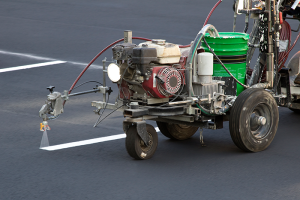Coordinated effort reaches from top leadership to front-line employees

Carilion Roanoke Memorial Hospital
Image courtesy of Carilion Clinic
In a hospital the size of Carilion Roanoke Memorial Hospital, Roanoke, Va., reducing the facility’s carbon footprint is an enormous challenge. But through a coordinated, facility-wide effort that touches everyone from top leadership to front-line employees, the hospital has drastically reduced its energy and water use, decreased medical supply and food waste by tens of thousands of pounds per year, and significantly slashed greenhouse gas emissions — all in a relatively short span of time.
Lights that burn 24/7 are a top target for energy reduction at Roanoke Memorial, a 1,279,00-square-foot hospital with a staff of approximately 7,100. In a nearly year-long project that involved every department on every floor, Roanoke Memorial replaced more than 30,000 fluorescent bulbs with LED lighting. Completed in 2018, the upgrade saves approximately $250,000 annually. To keep the momentum going, Carilion set a systemwide goal in 2021 to reduce energy use across all hospitals by an additional 3% by 2025.

Carilion Medical Center engineering and maintenance department members (front row, from left) Nick Aesy, Dan Johnson, Greg Cundiff, Mike Hampton, Jacob Dooley, Josh Tyree, Rick Massaro and Bill Battin; and (back row, from left) Jesse Showalter, Seth Spence, Rob Dickenson, Matt Davis, Tommy Battin, Danny Walton, Phillip Chitwood, Bill Becker and Daniel Rakes.
Image courtesy of Carilion Clinic
Roanoke Memorial is one of seven hospitals owned and operated by Carilion Clinic, a not-for-profit health care organization based in Roanoke, Va., that serves approximately 1 million people.
“While getting buy-in to fund larger sustainability projects can be challenging, it makes a big difference if you can demonstrate the cost savings year to year,” says Sara Wohlford, R.N., MPH, sustainability director for Carilion Clinic. “This project more than pays for itself. And it is a huge demonstration of the hospital’s commitment to reducing its impact on the environment.”
Such dedication to sustainability has earned Roanoke Memorial the 2022 Energy to Care Sustainability Champion Award from the American Society for Health Care Engineering (ASHE) of the American Hospital Association. The prestigious award recognizes facilities that demonstrate outstanding leadership in health care sustainability.
“Carilion Roanoke Memorial Hospital demonstrated success through its work in reducing waste and energy, providing healthier food alternatives, and through their partnerships and collaboration with organizations like ASHE. They’ve also set goals to green the operating room through setting back HVAC controls and converting to LED lighting,” says Kara Brooks, LEED AP BD+C, senior associate director of sustainability for ASHE.

Nick Aesy (on ladder), maintenance and electrician specialist, and Danny Walton, facility maintenance mechanic, retrofit a can light with LED hardware.
Images courtesy of Carilion Clinic
Roanoke Memorial’s sustainability efforts are supported by a systemwide program, including an environmental stewardship council comprised of Carilion senior leaders who provide guidance and oversight for sustainability initiatives. Workgroups under the council’s umbrella focus on specific sustainability issues. For example, Carilion’s goal to reduce energy by 3% falls under the leaner energy workgroup and is managed by a systemwide team including the hospital’s facilities and maintenance staff.
A sustainability department staffed by a director and coordinator works with individual facilities systemwide. A systemwide sustainability champions committee is open to all staff.
Saving energy, cutting emissions
In addition to lighting, the facility also has upgraded the burners for its boilers to newer models that burn natural gas more efficiently, slashing greenhouse gas emissions. This work has saved an estimated 17,317 therms per year, which translates into a decrease of 91.6 metric tons of carbon dioxide (CO2), or the equivalent of driving 19.7 gasoline-powered cars and generating energy for 11.5 homes — both for one year.

Mike Hampton, maintenance and HVAC specialist, reviews an operator display on a programmable controller for an air handler.
Images courtesy of Carilion Clinic
“The new burners are so much more efficient than our previous models. They have had a major impact on energy savings and performance,” says Greg Cundiff, engineering and maintenance supervisor. “This project was another big step in the right direction.”
Such projects have dramatically increased the facility’s Environmental Protection Agency ENERGY STAR® score in just over a decade. In 2007, Roanoke Memorial’s ENERGY STAR score was 50. By 2019, it was 84. In 2021, the hospital scored 76, a dip attributed to the COVID-19 disruption. ASHE requires Sustainability Champions to have an ENERGY STAR score of 75. Roanoke Memorial received ENERGY STAR certification in 2018, 2019 and 2021 for superior energy performance.
Along with goal setting, planning, monitoring and benchmarking, having a dedicated staff is equally critical to sustainability success. And because that requires buy-in from all employees, leaders are dedicated to raising awareness and identifying small ways employees can make a difference, says Marina Sotelo, efficiency and sustainability coordinator.

Chris Thompson, maintenance and HVAC specialist, consults a boiler display.
Images courtesy of Carilion Clinic
“The clinical staff can’t retrofit a building or switch out a ballast, but they can do easy things like identifying equipment that doesn’t need to be running, turn out lights and consolidate printers,” Sotelo says.
Moving forward, Roanoke Memorial will build on decarbonization efforts. Since 2009, the hospital has maintained a 1,700 metric ton decrease in CO2 emissions each year. The health care system is beginning the three-scope process outlined by the Greenhouse Gas Protocol organization for measuring CO2 emissions.
The facility also is integrating decarbonization into new building designs. Roanoke Memorial’s $500 million facility expansion will include a cogeneration plant that will create its own electricity and use the heat produced by the generators to heat the water that will be used in the new tower, which will dramatically cut emissions and energy costs.
“This will be part of a systemwide decarbonization plan that will significantly reduce our carbon footprint and improve the environment for patients, staff, visitors and the local community,” Wohlford says.




